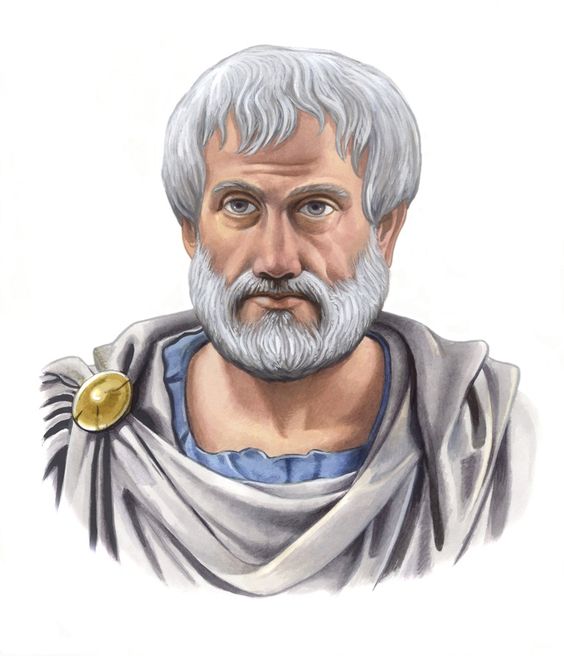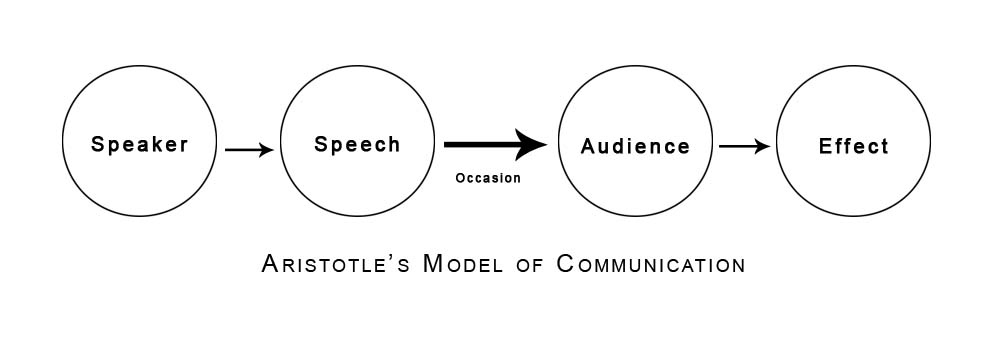Aristotle Linear Model of Communication
Models of communication are conceptual models, which are used to describe the mechanism of human communication.
Who is Aristotle?
Aristotle was a Greek philosopher and writer born in Stagira, Northern Greece, in 384BC. He is also considered to have been the teacher of Alexander the Great. Aristotle studied physics, logic, mathematics, etc.

Aristotle Linear Model of Communication
Aristotle developed Aristotle’s Linear model of communication before 300 BC. Aristotle’s communication model is straightforward to understand because the speaker’s primary focus is the speech.
In Aristotle’s communication model, the speaker has the most important role. Speaker is the only one who is active because the speaker’s role is to deliver a speech to the audience, and the audience is passive because the speech influenced it. That is why the model called a speaker centered model.
This makes the communication process one way from speaker to receiver. The speakers are tasked to deliver a speech to the audience, while on the other side, the audience role is being passively influenced only by the speech. This makes the communication one way from speaker to receiver.
Before a speaker delivers his or her speech, it must be planned according to the target audience and situation or occasion. The speech must be prepared so that the audience will be persuaded by our influence from the speaker’s speech.
Five Element of Aristotle Model of Communication
Aristotle’s Model of Communication is formed with 5 essential elements. They include;
- Speaker
- Speech
- Occasion
- Audience
- Effect

Speaker
Speaker is the center of the communication process, and that speaker has a speech. Basically, it’s about persuading or convincing someone for the information he is about to deliver and pretty.
Speech
Speech is the message the speaker is delivering to the audience.
Audience
The audience is the listener during the speech.
Effect
The effect could be positive or negative, and it depends on the speaker’s influence on the audience.
Occasion
It is the period or the type of event that brings the audience together. E.g., During an election campaign that brings people together.
Aristotle believed in Rhetorics Studies. Rhetorics Study is the study of communication and persuasion. Different messages or speeches should be made for different audiences and different situations to get hard facts or establish propaganda. The “Rhetoric” or language is designed to influence its audience persuasively or impressively.
This model was highly used to develop public speaking skills and create propaganda at that time. It is less focused on interpersonal or interpersonal communication. It was extensively used at the time to improve public speaking skills and generate propaganda.
But in this model is only speaker-oriented and focuses on audience interaction and communication. Therefore there is no concept of feedback.
Aristotle Linear Model of Communication Example
A politician giving a speech to the public ( civilians) during the campaign trail.
A politician( the speaker ) gives a speech to get votes from the civilian or the audience at a time of election campaigns (occasion). The civilians only vote (Effect) if politicians’ policies influence them in his speech.
So the content must be impressive to influence the mass, and the speaker must carefully design the message.
What makes someone a good communicator according to Aristotle Linear Model of Communication
According to Aristotle’s Model of Communication, these are the three critical elements to be a good communicator;
- Ethos
- Pathos
- Logos
Ethos
Ethos, the Greek word for custom or character ethos, is all about credibility. It is the characteristic that makes you credible in front of the audience. The person or the speaker itself must be credible, which would make people listen. Again, it has an area of expertise that would make people believe through experience and achievements.
Example of Ethos
Jack Ma, a businessman and the chairman of Alibaba Group of Companies. His credibility and achievement eight people listened to his story and achieved success with hard work, consistency, and patients.
Pathos
Pathos means emotion or experience. It means you must establish a bond, which would crack the listeners to feel you and relate what you are saying based on experience and perspective. It is trying to appeal to the emotional needs and sway them emotionally.
This is all about breaking an emotional bond that would influence the listener’s perception of this speaker or leader’s effectiveness.
Example of Pathos
For instance, a business convention where many entrepreneurs, small-time business owners seek guidance in experience business people. As a speaker, you must establish a bond between you and your audience that shares the same experience from bottom to top before you reach your senses.
Logos
Logos is basically logic. People believe in you only if you appeal to their logic. Logos is your reasoning or argumentation. You must present facts that would capture the attention and make them interested. This could be by providing analytical data, results, information which makes the audience believe you. It is about the logical appeal.
Criticisms of Aristotle Linear Model of Communication
- One disadvantage of Aristotle’s communication model is that there is no feedback to express their ideas and opinions to the speaker. This is just one way from speaker to audience.
- There is no concept of communication failures like noise and barriers. Practically, there could be things like background noise for the crowd, noise from the public address systems, etc.
- This model can only be used in public speaking, which means for a crowd or adverse incidents for the mass gathering.






